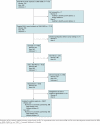Gender differences in time spent on parenting and domestic responsibilities by high-achieving young physician-researchers
- PMID: 24737273
- PMCID: PMC4131769
- DOI: 10.7326/M13-0974
Gender differences in time spent on parenting and domestic responsibilities by high-achieving young physician-researchers
Abstract
Background: Female physician-researchers do not achieve career success at the same rate as men. Differences in nonprofessional responsibilities may partially explain this gap.
Objective: To investigate the division of domestic labor by gender in a motivated group of early-career physician-researchers.
Design: Nationwide postal survey between 2010 and 2011.
Setting: United States.
Participants: Physician recipients of National Institutes of Health K08 or K23 awards between 2006 and 2009 with active academic affiliation at the time of the survey.
Measurements: Time spent on parenting and domestic tasks was determined through self-report. Among married or partnered respondents with children, a linear regression model of time spent on domestic activities was constructed considering age, gender, race, specialty, MD or MD/PhD status, age of youngest child, number of children, work hours, K award type, and spousal employment.
Results: A 74% response rate was achieved, and 1049 respondents were academic physicians. Women were more likely than men to have spouses or domestic partners who were employed full-time (85.6% [95% CI, 82.7% to 89.2%] vs. 44.9% [CI, 40.8% to 49.8%]). Among married or partnered respondents with children, after adjustment for work hours, spousal employment, and other factors, women spent 8.5 more hours per week on domestic activities. In the subgroup with spouses or domestic partners who were employed full-time, women were more likely to take time off during disruptions of usual child care arrangements than men (42.6% [CI, 36.6% to 49.0%] vs. 12.4% [CI, 5.4% to 19.5%]).
Limitations: Analyses relied on self-reported data. The study design did not enable investigation of the relationship between domestic activities and professional success.
Conclusion: In this sample of career-oriented professionals, gender differences in domestic activities existed among those with children. Most men's spouses or domestic partners were not employed full-time, which contrasted sharply with the experiences of women.
Primary funding source: National Institutes of Health.
Figures
Comment in
-
A woman physician-researcher's work is never done.Ann Intern Med. 2014 Mar 4;160(5):359-60. doi: 10.7326/M14-0218. Ann Intern Med. 2014. PMID: 24737274 No abstract available.
-
Gender differences in time spent on parenting and domestic responsibilities.Ann Intern Med. 2014 Oct 7;161(7):533. doi: 10.7326/L14-5019-4. Ann Intern Med. 2014. PMID: 25285550 No abstract available.
-
Gender differences in time spent on parenting and domestic responsibilities.Ann Intern Med. 2014 Oct 7;161(7):533-4. doi: 10.7326/L14-5019-5. Ann Intern Med. 2014. PMID: 25285551 No abstract available.
-
Gender differences in time spent on parenting and domestic responsibilities.Ann Intern Med. 2014 Oct 7;161(7):534. doi: 10.7326/L14-5019-6. Ann Intern Med. 2014. PMID: 25285552 No abstract available.
-
Gender differences in time spent on parenting and domestic responsibilities.Ann Intern Med. 2014 Oct 7;161(7):534. doi: 10.7326/L14-5019-7. Ann Intern Med. 2014. PMID: 25285553 No abstract available.
References
-
- Waite LJ, Nielsen M. The rise of the dual-earner family, 1963–1997. In: Hertz R, Marshall NL, editors. Working Families: The Transformation of the American Home. Univ of California Pr; Berkeley, CA: 2001. pp. 23–41.
-
- Bianchi SM, Milkie MA, Sayer LC, Robinson JP. Is anyone doing the housework? Trends in the gender division of household labor. Social Forces. 2000;79:191–228.
-
- Coltrane S. Research on household labor: Modeling and measuring the social embeddedness of routine family work. J Marriage Fam. 2000;62:1208–33.
-
- Blau FD, Kahn LM. The gender pay gap. Economists’ Voice. 2007 Jun;:1–6.
-
- Breen R, Cooke LP. The persistence of the gendered division of domestic labour. Eur Sociol Rev. 2005;21:43–57.
Publication types
MeSH terms
Grants and funding
LinkOut - more resources
Full Text Sources
Other Literature Sources
Medical
Miscellaneous


